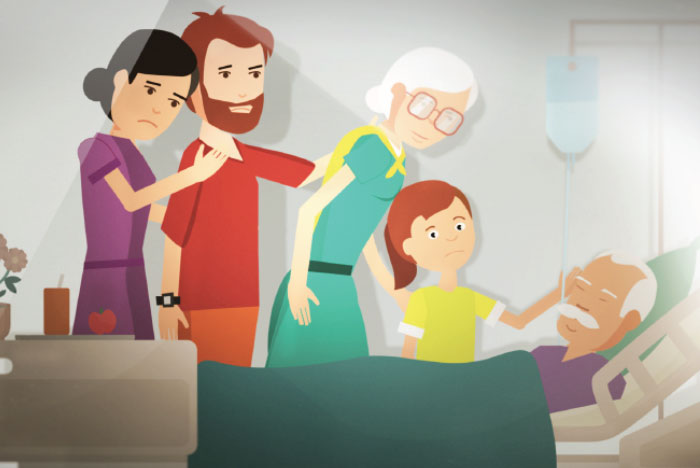
The Art of Dying Well - St Mary’s University, is today launching a new Guide to Deathbed Etiquette - written to help families and friends support a dying loved one.
The guide builds on the wisdom and experience of those who have been by the bedside in the last few weeks, days, hours, minutes and indeed seconds of their loved one’s life. They include leading palliative care consultants, nurses, chaplains, friends and relatives.
Jo Elverson, a consultant in palliative medicine at St Oswald’s Hospice, Newcastle has found that those closest to the dying person are best placed to help them to die peacefully.
Jo encourages families at the bedside to follow their instincts: “Sometimes, they need confidence, permission if you like, to do what they believe is the right thing.”
She tells the story of a 17-year-old patient who was dying of sarcoma cancer at home and becoming very breathless and distressed. She realised this was because he was aware of his father’s deep distress. She and the community nurse asked the father if he could reassure his son.
Jo says: “Dad was able to say: ‘I’m going to be all right. I’ve got your mum, I’ve got your sister. I’m going to be OK.’ And this did more than any medicine for his son so he was able to relax and rest. He died the next day.”
Carolyne Barber, who has been a nurse for 32 years and is a lecturer in nursing palliative care at St Joseph’s Hospice, Hackney, says that people who are dying sometimes seek help with healing fractured relationships. She recalls one case when a dying mother asked her to speak to her estranged daughter who was about to visit from America. Mother and daughter were reconciled and had three weeks together.
Carolyne says: “Even after the daughter went back to America, there was a sense of relief and freshness in the mother. The atmosphere was profoundly different.
“The daughter spoke to her mother by phone every night and on the night she died was able to say she loved her one last time. The mother was unconscious by then but we could tell from her facial expression that she could hear her daughter.”
Patients have also spoken to Carolyne about dead relatives coming to meet them. She recalls what happened with one very sick patient with whom she had built a great rapport: “I’d just done a night shift and I popped in to say ‘I’m off home see you tonight’ but she looked at me with a strange expression. I could see she wanted to talk so I sat down. She said ‘No you won’t see me tonight. I saw something in the night. I saw my mum. I don’t think I’m going to see you again.’ I asked her if she was feeling any worse, but she said her breathlessness was the same. I left her with a sense of wonder about whether that really was goodbye and noted it for my colleagues.
“When I came in on the night shift I was told she had had a sudden cardiac event and died. Her family were called in and her death was very peaceful.”
Amy Gadoud, a palliative care consultant at Trinity Hospice in Blackpool, hopes that the Guide to Deathbed Etiquette will increase people’s trust in doctors and nurses. She says that even when a patient is close to death, the family sometimes can’t accept it and ask doctors to try to prolong the patient’s life with further active treatment.
“We need to communicate that dying is not a clinical event. It is a normal event in someone’s life,” Amy says.
The launch of the guide coincides with a Onepoll survey commissioned by the Art of Dying Well - St Mary’s University that asked 2,000 people across the UK whether they were prepared to be at the bedside of a loved one as they were dying. They were requested to rate their responses from one to 10, one being totally unprepared and 10 totally prepared.
Sixteen per cent said they were totally prepared, while one in 10 were totally unprepared.
By rolling together responses one to five and five to 10, it emerged that almost half of those polled – 48% – felt prepared to some extent while 39% veered towards feeling unprepared.
Women outnumbered men in their responses to the two most extreme positions. Almost twice as many women as men said they were totally prepared – 20% of women and 11% of men. More women than men also considered themselves to be totally unprepared – 12% of women and 8 per cent of men.
Older respondents said they felt better prepared to sit by the bedside. Almost a quarter of people aged over 55 (23%) said they were totally prepared, while only 12% for those aged 18 to 34 felt this way. This finding is in line with the experience of our experts who have found that the ability to cope with death and dying increases with age.
Amy Gadoud says: “I’ve seen a grandfather who is terminally ill supporting his grandchildren who are finding it all very difficult. Once a person is in their eighties, they’re at the stage of losing friends and it is becoming familiar. The young don’t usually have that experience so the difference is understandable.”
Media enquiries
For media enquiries, please contact:

Press team
020 8240 8262